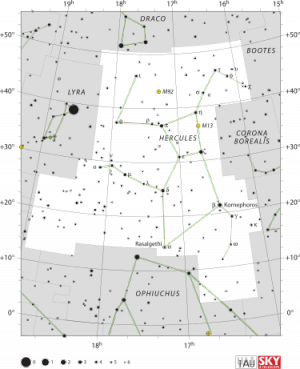Hercules
Hercules is a constellation named after Hercules, the Roman mythological hero adapted from the Greek hero Heracles. Hercules was one of the 48 constellations listed by the 2nd century astronomer Ptolemy, and it remains one of the 88 modern constellations today. It is the fifth largest of the modern constellations. Fifteen stars in Hercules are known to be orbited by extrasolar planets.
Hercules contains two bright globular clusters: Messier 13, the brightest globular cluster in the northern hemisphere, and Messier 92. It also contains the nearly spherical planetary nebula Abell 39. M13 lies between the stars η Her and ζ Her; it is dim, but may be detected by the unaided eye on a very clear night.The Hercules Cluster (Abell 2151) is a cluster of galaxies in Hercules.The Hercules–Corona Borealis Great Wall, the largest structure in the universe, is in Hercules.
History
According to Gavin White, the Greek constellation of Hercules is a distorted version of the Babylonian constellation known as the "Standing Gods" (MUL.DINGIR.GUB.BA.MESH). White argues that this figure was, like the similarly named "Sitting Gods", depicted as a man with a serpent's body instead of legs (the serpent element now being represented on the Greek star map by the figure of Draco that Hercules crushes beneath his feet). He further argues that the original name of Hercules – the 'Kneeler' (see below) – is a conflation of the two Babylonian constellations of the Sitting and Standing Gods. The earliest Greek references to the constellation do not refer to it as Hercules. Aratus describes it as follows:
Right there in its Draco's orbit wheels a Phantom form, like to a man that strives at a task. That sign no man knows how to read clearly, nor what task he is bent, but men simply call him On His Knees [Ἐγγόνασιν "the Kneeler"].
Now that Phantom, that toils on his knees, seems to sit on bended knee, and from both his shoulders his hands are upraised and stretch, one this way, one that, a fathom's length. Over the middle of the head of the crooked Dragon, he has the tip of his right foot. Here too that Crown [Corona], which glorious Dionysus set to be memorial of the dead Ariadne, wheels beneath the back of the toil-spent Phantom. To the Phantom’s back the Crown is near, but by his head mark near at hand the head of Ophiuchus [...] Yonder, too, is the tiny Tortoise, which, while still beside his cradle, Hermes pierced for stings and bade it be called the Lyre [Lyra]: and he brought it into heaven and set it in front of the unknown Phantom. That Croucher on his Knees comes near the Lyre with his left knee, but the top of the Bird’s head wheels on the other side, and between the Bird’s head and the Phantom’s knee is enstarred the Lyre.
The story connecting Hercules with the constellation is recounted by Dionysius of Halicarnassus:
On his way back to Mycenae from Iberia having obtained the Cattle of Geryon as his tenth labour Heracles came to Liguria in North-Western Italy where he engaged in battle with two giants, Albion and Bergion or Dercynus. The opponents were strong; Hercules was in a difficult position so he prayed to his father Zeus for help. With the aegis of Zeus, Heracles won the battle. It was this kneeling position of Heracles when prayed to his father Zeus that gave the name "the Kneeler"and Hyginus.
Hercules is also sometimes associated with Gilgamesh, a Sumerian mythological hero.
Mythology
This constellation is said to represent the Roman Hercules, Greek Herakles, who was the greatest of the Greek heroes and famous for his twelve labors. As an infant Hercules strangled two serpents sent by Juno to kill him as he lay asleep in his cradle. It is suggested that the two serpents represent the the Lunar Nodes. He died on a funeral pyre, became a god, and ascended to Mount Olympus to join the other gods. Engonasin is a Greek title for Hercules, with Roman writers translating it Geniculator or Geniculatus; these terms meaning 'the Kneeling Man'.The name Hercules is from a Latin translation of Greek Herakles. Herakles' name is translated 'the glory of Hera' or 'the fame of Hera', the prefix of his name relates to Hera, wife of Zeus.
Heracles was the son of the god Zeus and a mortal woman, Alcmene, whom Zeus visited in the form of her husband, Amphitryon. Early in life Herakles was called Alcaeus, or Alcides, after his mother Alcmene, the name Heracles came later. Heracles comes from Hera + kles, and is translated 'the glory of Hera.' The Hera- in his name refers to Hera (Roman Juno), wife of Zeus (Roman Jupiter). His name is somewhat ironic as the events in the myth of Herakles are motivated by the unrelenting hostility of Hera toward him for being Zeus' illicit son. The etymology of his name as 'the glory of Hera' is unmistakable as the Greeks understood it; "as the hero's name makes clear, he owes his heroic identity to his kleos and, ultimately, to Hera" , even though she persecuted, and tried to eliminate him throughout his life. Hercules becomes reconciled with Hera through death and marries her daughter Hebe on Mount Olympos.[1]
HGS Session References
HGS Sessions - Clearing Hyperspace Phantom Matrix - 3/12/2015 [2]
References
Found in HGS Manual on Page 108
Found in HGS Manual on Page 115
